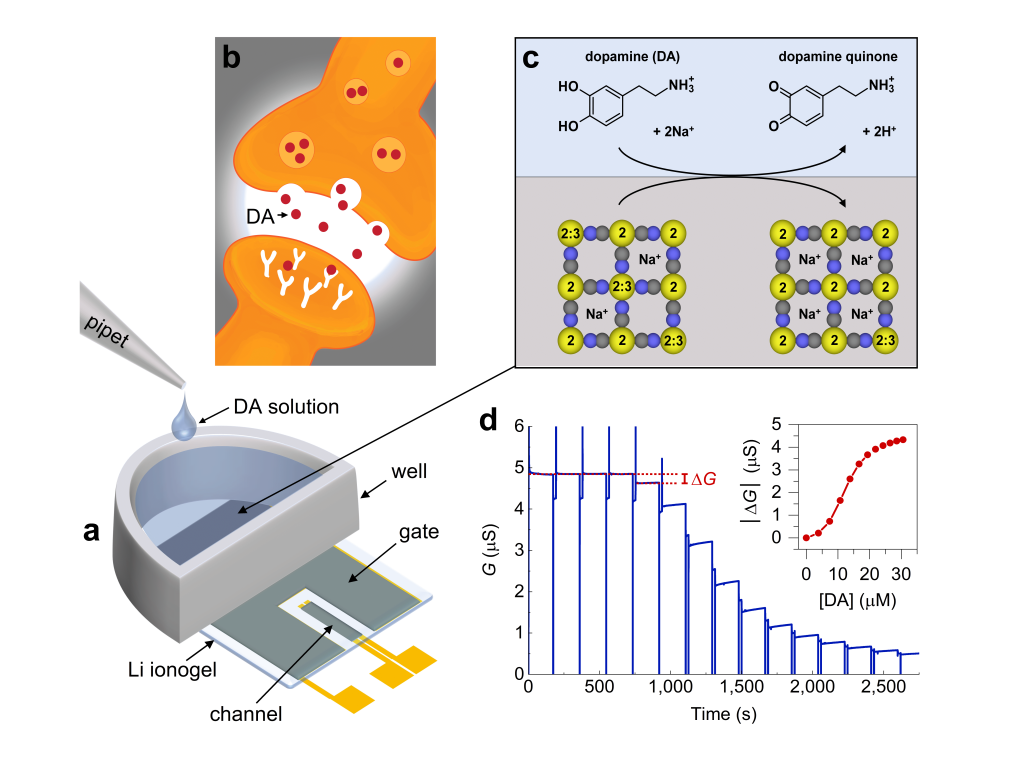Analog Neuron Device for Brain-Computer Interface
A computing hardware approach that aspires to emulate the brain. Ruthenium-based Prussian blue analogue for artificial synapses have transformational potential in neuroprosthetics, brain disease diagnostics, and ubiquitous edge computing.
In an aspiration to emulate the human brain, neuromorphic computing using arrays of artificial synapses have emerged as an exciting field of study. Those synapses are mainly based on lab-created, non-volatile resistive memory elements. However, efficient learning and scalability to large, deep neural networks has proven difficult due to accuracy limitations of conventional memristor-based computing elements. To address this limitation, Sandia researchers have introduced a ruthenium (RU)-based Prussian blue analogue as an efficient active material for inkjet-printed lithium (Li) ion and proton-based nonvolatile electrochemical synapses. They have modeled the system for understanding electronic conduction in extended mixed-valence coordination compounds and elucidated the superiority of Ru-based analogue over the parent compound, Prussian blue.
An artificial synapse device has been developed at Sandia based on the synaptic transistor concept, tunable ionic electronic transistor. This class of devices are commonly known as electrochemical random-access memory (ECRAM). Most ECRAM devices are now being considered for creating circuits for low-power brain-inspired computing systems, based on their spiking and non-spiking neural networks. This invention presents a new material for fabricating ECRAM that is particularly attractive for brain-computer interfacing. Brain-computer interfaces (BCIs) and emerging device technology for brain-inspired computing are attracting increasing attention due to their transformational potential in neuroprosthetics, brain disease diagnostics, and ubiquitous edge computing. In the current device, the channel and the gate consist of Ru Prussian blue analog (Ru-PBA) and metal contacts for source, drain, and gate. This device can also be fabricated on flexible plastic substrates. An electrolyte consisting of an ionogel containing a Li-ion or proton conducting electrolyte connects the gate and the channel. Application of appropriate bias (typically <1V) moves ions and electron in/out of the channel, changing its electronic conductance that represents the synaptic weight. In addition, the Ru-PBA material is compatible with biological neurons, meaning that the neurons can remain alive on the surface of the Ru-PBA for at least 3 days so long as appropriate nutrients are supplied. Furthermore, the Ru-PBA synapse is sensitive to dopamine, an important neurotransmitter. Thus, this device carries a great potential application to connect biological and artificial neural networks.
- Microscopic Ru-PBA ECRAM devices can significantly lower the gating resistance and increase the overall switching efficiency for scaling purposes
- Illustration of Ru-based analogue superiority over parent compound, Prussian blue
- Unique architecture and methodology for dopamine sensing from other electrochemical transistor approaches
- Connect biological and artificial neural networks
- Neuroprosthetics
- Brain disease diagnostics
- Edge computing

a) a schematic of dopamine sensing. b) Illustration of dopamine release from vesicles of a presynaptic neuron (top) to receptors of a postsynaptic neuron (bottom). c) Schematic of dopamine reaction with Ru-PBA in the portion
of the device gate enclosed by the well. d) Conductance trace during incremental additions of dopamine and inset showing corresponding dose-response plot.
SD 16053
Published6/5/2023
Last Updated1/20/2025